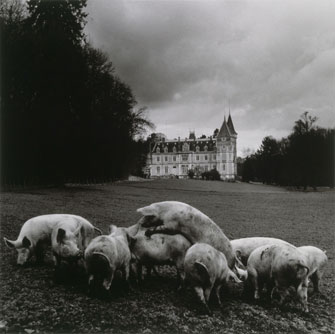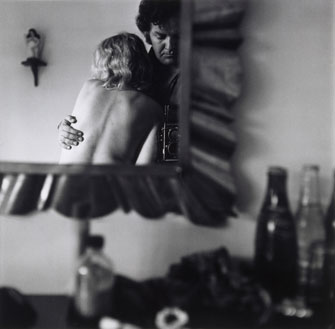Images Plucked from
The Sludge of History

”La Vie de Château” (1973) by Philippe Salaün. © Philippe Salaün. Collection Maison Européenne de la Photographie, Paris
Any exhibition that attempts to cover a time span of more than 30 years or works by more than one artist should be considered ambitious. “La Photographie en France, 1950-2000,” the latest show at the Maison Européenne de la Photographie in the Marais does both these things and more, directing its gaze at the development and landmarks of French photography over the last half-century.
Though it is by no means a gaze that registers all, most of the major pictures taken by French photographers in the last 50 years make an appearance. As soon as visitors enter the 1950s room at the show’s beginning, they are plunged into a soup of nostalgia by the familiar sight of Robert Doisneau’s “Le Baiser à l’Hotel de Ville,” showing a young couple passionately embracing to the general indifference of passersby. So iconic as to be almost a cliché, the photograph is still impressive, and its brazen romanticism still beguiling. Along with other Doisneau pieces, it creates an intriguing contrast with Izis’ “J-13 Avant Noël” (also 1950), an odd picture of two dour flower sellers waiting beneath tasseled umbrellas in the Place Victor-Basch for customers who seem unlikely to materialize. The buildings behind the pair are recognizable, but their clothes, their facial expressions and the cars just visible in the background erect an impermeable barrier around them, confining them to their era and reminding viewers of just how much social change France has seen since the 1950s.
The show is divided up into five sections, with separate rooms for each decade. All is arranged in chronological order, and visitors are guided around the pictures with the help of a timeline at knee-height, which records the most important historical moments of the passing years both in France and abroad. Thus a useful bridge is made between the pictures (whose subjects are often political) and the course of global history. It is a dialogue that informs and illuminates, aiding viewers in their increasingly desperate attempt to contextualize the enormous number of pictures on display and anchor them to a broader pattern of meaning. Even with the timeline, however, an abiding sensation of disorientation and excess remains.
Of all the five decades presented, the 1960s room is perhaps the most impressive, or at least the most dramatic. Black and white gives way to color, but the theme of the pictures darkens in line with the convulsions occurring outside the Hexagon, such as the Vietnam War, the invasion of Czechoslovakia and the uprisings in Southern Europe. At this point, France had fallen behind in photographic terms: here, the taking of pictures was yet to be recognized as a respectable art or legitimate occupation. However, the efforts of those French photographers who traveled abroad in the Sixties, sometimes commissioned by magazines like Life, did much to rehabilitate photography’s status, both in the eyes of France’s own people and in those of its foreign

“19 Juillet 1978. Taxco, Mexique. Hôtel Victoria, Chambre 80” by Denis Roche. © Denis Roche. Collection Maison Européenne de la Photographie, Paris.
critics. Prominent among this series of photos are those taken by Henri Cartier-Bresson on his year-long trip to China, which reveal an impoverished country abundant in humanity and complexity.
“La Photographie en France: 1950-2000” is not a modest exhibition, but a grandiose and gluttonous one, whose eyes, though sharp and perceptive, are greedier than its stomach. While there can be no question as to the quality of many of the photographs on display, there is almost too much to see for the deserving pictures to be able to greatly stand out. Visitors may have difficulty in remembering individual images, in extricating them from the sludge of history and nostalgia that the exhibition pays homage to. This is just as much a photography show as an (admirably) illustrated crash course in international relations over the past 50 years – one which, unfortunately, privileges quantity over quality and facts over feelings.
La Maison Européenne de la Photographie: 5/7 rue de Fourcy, 75004 Paris. Métro: Saint Paul. Tel.: 01 44 78 75 00. Open Wednesday-Sunday, 11am-80m. Admission: €7. www.mep-fr.org
Reader reaction: Click here to respond to this article (your response may be published on this page and is subject to editing).
Please support Paris Update by ordering books from Paris Update’s Amazon store at no extra cost. Click on your preferred Amazon location: U.K., France, U.S.
More reviews of Paris art shows.
© 2012 Paris Update
Favorite